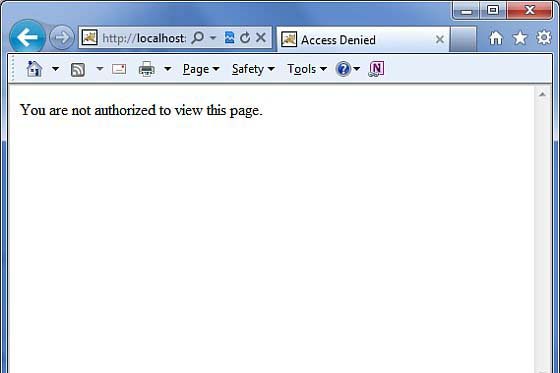動作是Struts2框架的核心,因為他們的任何MVC(模型 - 視圖 - 控制器)框架。每個URL將被映射到一個特定的動作,它提供了來自用戶的請求提供服務所需的處理邏輯。
但動作也提供其他兩個重要的能力。首先,操作從請求數據的傳輸中起著重要的作用,通過向視圖,無論是一個JSP或其他類型的結果。二,動作必須協助的框架,在確定結果應該渲染視圖,在回應該請求將被退回。
創建動作:
在Struts2的動作,唯一的要求是必須有一個無參數的方法返回String或結果的對象,必須是一個POJO。如果不帶參數的方法是不指定,則默認動作是使用execute()方法。
也可以選擇擴展ActionSupport類實現了6個介面,包括動作介面。動作介面如下:
public interface Action { public static final String SUCCESS = "success"; public static final String NONE = "none"; public static final String ERROR = "error"; public static final String INPUT = "input"; public static final String LOGIN = "login"; public String execute() throws Exception; }
讓我們來看看Hello World示例的操作方法:
package com.zaixian.struts2; public class HelloWorldAction{ private String name; public String execute() throws Exception { return "success"; } public String getName() { return name; } public void setName(String name) { this.name = name; } }
為了說明這一點,操作方法控制視圖,讓我們做出以下更改執行方法和擴展類ActionSupport 如下:
package com.zaixian.struts2; import com.opensymphony.xwork2.ActionSupport; public class HelloWorldAction extends ActionSupport{ private String name; public String execute() throws Exception { if ("SECRET".equals(name)) { return SUCCESS; }else{ return ERROR; } } public String getName() { return name; } public void setName(String name) { this.name = name; } }
在這個例子中,我們有一些在execute方法的邏輯來看待的name屬性。如果屬性等於字串“SECRET”,我們返回SUCCESS 的結果,否則我們返回ERROR 的結果。因為我們已經擴展ActionSupport,所以我們可以使用字串常量的成功和錯誤。現在,讓我們修改我們的struts.xml檔如下:
<?xml version="1.0" encoding="UTF-8"?> <!DOCTYPE struts PUBLIC "-//Apache Software Foundation//DTD Struts Configuration 2.0//EN" "http://struts.apache.org/dtds/struts-2.0.dtd"> <struts> <constant name="struts.devMode" value="true" /> <package name="helloworld" extends="struts-default"> <action name="hello" class="com.zaixian.struts2.HelloWorldAction" method="execute"> <result name="success">/HelloWorld.jsp</result> <result name="error">/AccessDenied.jsp</result> </action> </package> </struts>
創建視圖
讓我們創建以下JSP檔 helloWorld.jsp 的WebContent檔夾在eclipse專案。要做到這一點,右鍵單擊WebContent檔夾在專案資源管理器,選擇New >JSP File。該檔將要求返回的結果是SUCCESS,這是一個字串常量“success”的定義在動作介面:
<%@ page contentType="text/html; charset=UTF-8" %> <%@ taglib prefix="s" uri="/struts-tags" %> <html> <head> <title>Hello World</title> </head> <body> Hello World, <s:property value="name"/> </body> </html>
以下是由框架的動作的結果將被調用的檔,該檔是等於字串常量“錯誤”的ERROR 。以下是AccessDenied.jsp 的內容
<%@ page contentType="text/html; charset=UTF-8" %> <%@ taglib prefix="s" uri="/struts-tags" %> <html> <head> <title>Access Denied</title> </head> <body> You are not authorized to view this page. </body> </html>
我們還需要在WebContent檔夾中創建index.jsp。該檔將作為初始動作URL,用戶可以直接點擊告訴Struts 2框架調用HelloWorldAction類的 execute方法,並呈現 helloWorld.jsp視圖。
<%@ page language="java" contentType="text/html; charset=ISO-8859-1" pageEncoding="ISO-8859-1"%> <%@ taglib prefix="s" uri="/struts-tags"%> <!DOCTYPE html PUBLIC "-//W3C//DTD HTML 4.01 Transitional//EN" "http://www.w3.org/TR/html4/loose.dtd"> <html> <head> <title>Hello World</title> </head> <body> <h1>Hello World From Struts2</h1> <form action="hello"> <label for="name">Please enter your name</label><br/> <input type="text" name="name"/> <input type="submit" value="Say Hello"/> </form> </body> </html>
就是這樣,不需要改變的web.xml檔,所以讓我們用同一個web.xml,是之前我們已經創建了範例章。現在,我們已經準備好運行使用Struts 2框架的 Hello World應用程式。
執行應用程式
右鍵點擊專案名稱,並單擊 Export > WAR File 創建一個WAR檔。然後在Tomcat 的webapps目錄下部署這個WAR。最後,啟動Tomcat伺服器和嘗試訪問URL http://localhost:8080/HelloWorldStruts2/index.jsp。這會給出以下畫面:

讓我們為“SECRET”,並輸入一個字,應該看到以下頁面:

現在輸入任何單詞而非“SECRET”,應該看到以下頁面:

建立多個動作:
經常會定義一個以上的動作,以處理不同的請求,並提供不同的用戶的URL,因此可以定義不同的類定義如下:
package com.zaixian.struts2; import com.opensymphony.xwork2.ActionSupport; class MyAction extends ActionSupport{ public static String GOOD = SUCCESS; public static String BAD = ERROR; } public class HelloWorld extends ActionSupport{ ... public String execute() { if ("SECRET".equals(name)) return MyAction.GOOD; return MyAction.BAD; } ... } public class SomeOtherClass extends ActionSupport{ ... public String execute() { return MyAction.GOOD; } ... }
在struts.xml檔中配置這些操作如下:
<?xml version="1.0" encoding="UTF-8"?> <!DOCTYPE struts PUBLIC "-//Apache Software Foundation//DTD Struts Configuration 2.0//EN" "http://struts.apache.org/dtds/struts-2.0.dtd"> struts> <constant name="struts.devMode" value="true" /> <package name="helloworld" extends="struts-default"> <action name="hello" class="com.zaixian.struts2.HelloWorld" method="execute"> <result name="success">/HelloWorld.jsp</result> <result name="error">/AccessDenied.jsp</result> </action> <action name="something" class="com.zaixian.struts2.SomeOtherClass" method="execute"> <result name="success">/Something.jsp</result> <result name="error">/AccessDenied.jsp</result> </action> </package> </struts>
正如看到在上述假設的例子,動作的結果是重複的SUCCESS和ERROR。要解決這個問題,建議創建一個類包含結果的結果。
